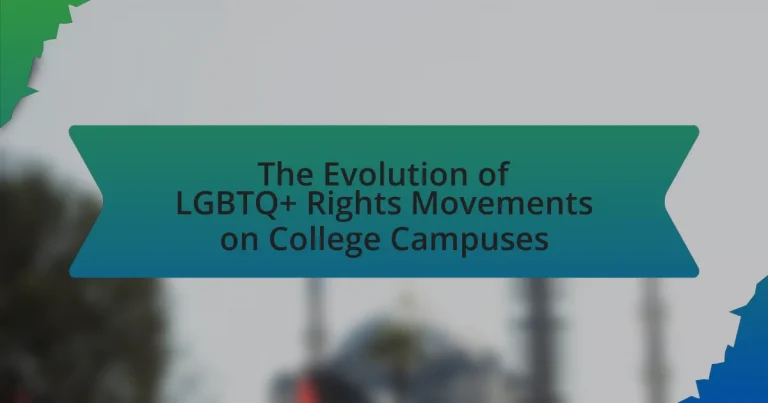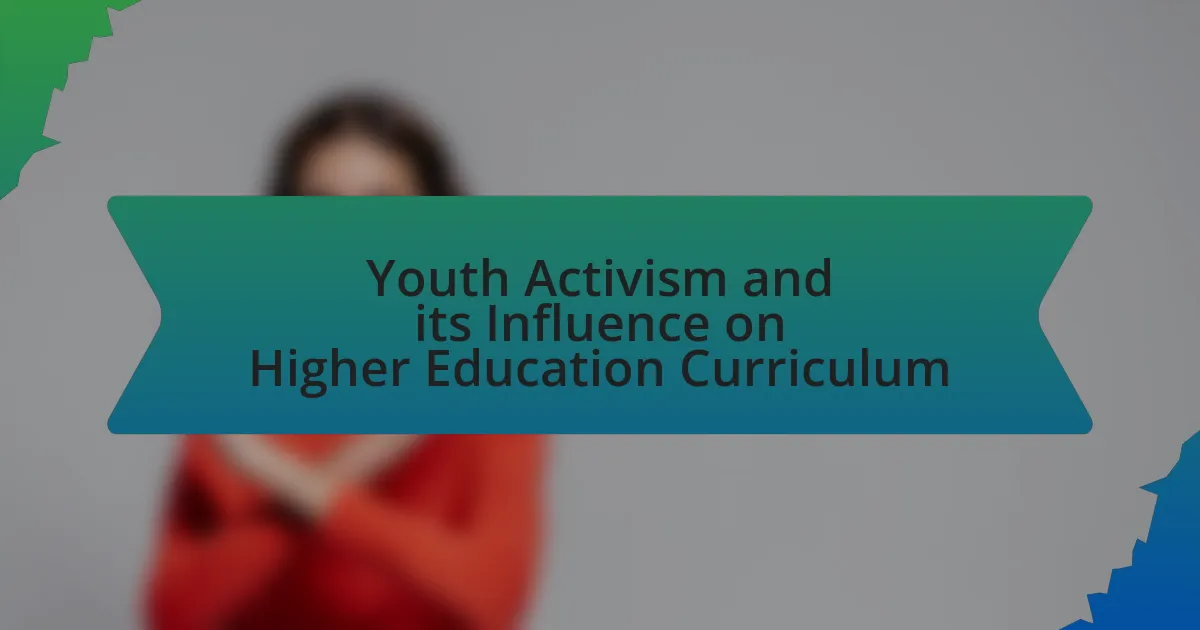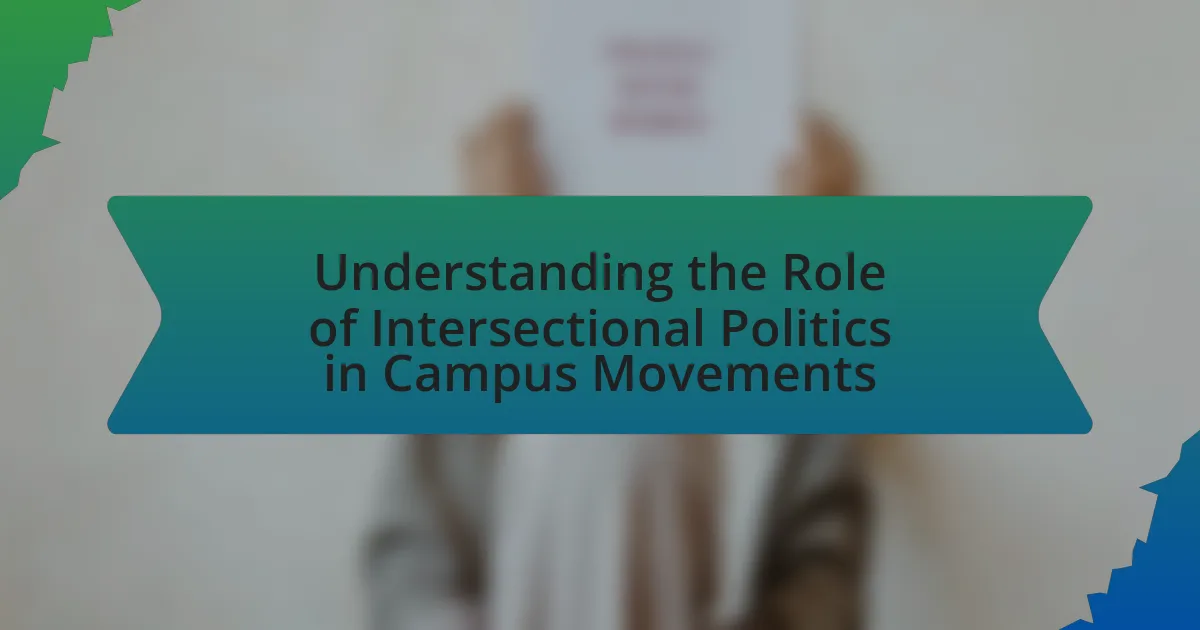The article examines the evolution of rights movements on college campuses, highlighting key historical milestones from the 1960s to the present. It details the establishment of early organizations, the impact of pivotal events like the Stonewall Riots, and the role of student activism in advocating for policy changes and inclusivity. The article also addresses current challenges faced by students, including discrimination and mental health issues, while exploring the influence of social media on activism. Additionally, it outlines initiatives colleges are implementing to support students and discusses future directions for advocacy, emphasizing the importance of intersectionality and community engagement.

What are the historical milestones of rights movements on college campuses?
The historical milestones of rights movements on college campuses include the establishment of the first student organizations in the 1960s, such as the Student Homophile League at Columbia University in 1967, which marked the beginning of organized advocacy. In 1970, the first marches took place, with college students playing a significant role in mobilizing support. The 1980s saw the emergence of AIDS activism, with student groups advocating for awareness and funding, exemplified by the formation of ACT UP in 1987. The 1990s introduced the inclusion of issues in campus policies, with many universities implementing non-discrimination policies. The 2000s and beyond have seen increased visibility and acceptance, highlighted by the establishment of resource centers and the inclusion of studies in academic curricula, reflecting a broader societal shift towards equality. These milestones demonstrate the evolving landscape of rights on college campuses, driven by student activism and changing societal attitudes.
How did early activism begin in higher education?
Early activism in higher education began in the 1960s, primarily as a response to systemic discrimination and the lack of representation for individuals on college campuses. Activists organized around issues such as the decriminalization of homosexuality and the establishment of safe spaces for students. The formation of groups like the Mattachine Society and the Daughters of Bilitis, which initially focused on broader societal change, inspired students to advocate for their rights within academic institutions. By the late 1960s, the first student organizations emerged, such as the Liberation Front at Columbia University in 1969, which played a crucial role in mobilizing students and raising awareness about issues. This activism laid the groundwork for future movements and the establishment of resource centers on campuses nationwide.
What were the key events that sparked movements in the 1960s and 1970s?
The key events that sparked movements in the 1960s and 1970s include the Stonewall Riots of 1969, which were a response to a police raid at the Stonewall Inn in New York City, and the formation of activist organizations such as the Liberation Front shortly thereafter. The Stonewall Riots are widely regarded as a catalyst for the modern rights movement, leading to increased visibility and activism. Following this, the first marches took place in 1970, commemorating the anniversary of the riots and further galvanizing the community. Additionally, the American Psychiatric Association’s decision in 1973 to remove homosexuality from its Diagnostic and Statistical Manual of Mental Disorders marked a significant shift in societal attitudes and contributed to the momentum of the movement.
How did the Stonewall Riots influence college activism?
The Stonewall Riots significantly influenced college activism by catalyzing the formation of student organizations and fostering a culture of political engagement on campuses. Following the riots in 1969, students began to organize around issues of sexual orientation and gender identity, leading to the establishment of groups such as the Liberation Front on various college campuses. This activism was characterized by increased visibility of issues, the promotion of safe spaces, and the demand for institutional changes, such as the inclusion of studies in curricula. The impact of the Stonewall Riots is evidenced by the rise of annual events and the incorporation of rights into broader social justice movements within academic institutions.
What role did student organizations play in the evolution of rights?
Student organizations played a crucial role in the evolution of rights by providing a platform for advocacy, community building, and education. These organizations, such as the Liberation Front founded in the late 1960s, mobilized students to challenge discriminatory policies and promote awareness of issues on campuses. They organized events, protests, and discussions that highlighted the need for equal rights and acceptance, significantly influencing public opinion and institutional policies. For instance, the establishment of resource centers on many campuses in the 1980s and 1990s can be traced back to the efforts of these student groups, which pushed for safe spaces and support systems for individuals. Their activism not only fostered a sense of belonging among students but also contributed to broader societal changes, leading to increased legal protections and recognition of rights over time.
What were some of the first student organizations established on campuses?
Some of the first student organizations established on campuses include the Liberation Front at Columbia University in 1969 and the Student Homophile League at New York University in 1969. These organizations emerged in response to the growing need for advocacy and support within academic environments during a time of significant social change. The Liberation Front was pivotal in promoting rights and visibility, while the Student Homophile League focused on creating a safe space for students and fostering community. Their establishment marked a crucial step in the evolution of rights movements on college campuses, laying the groundwork for future advocacy and support networks.
How did these organizations impact campus culture and policies?
rights organizations significantly transformed campus culture and policies by advocating for inclusivity and equality. These organizations, such as the Liberation Front and campus-based groups, initiated dialogues around sexual orientation and gender identity, leading to the establishment of safe spaces and support services for students. For instance, the implementation of non-discrimination policies in many universities was a direct result of sustained advocacy efforts, which often included protests, awareness campaigns, and educational programs. Research indicates that campuses with active organizations report higher levels of acceptance and lower instances of harassment, demonstrating the positive impact these groups have on creating a more inclusive educational environment.
What legislative changes have influenced rights on campuses?
Legislative changes such as the enactment of Title IX amendments and the legalization of same-sex marriage have significantly influenced rights on campuses. Title IX, which prohibits sex-based discrimination in federally funded education, has been interpreted to include protections for students, leading to increased support and resources for these individuals. Additionally, the 2015 Supreme Court ruling in Obergefell v. Hodges, which legalized same-sex marriage nationwide, has fostered a more inclusive environment on campuses, prompting institutions to adopt policies that support students and recognize same-sex partnerships. These legislative milestones have contributed to the advancement of rights and the establishment of safer, more equitable educational settings.
How have Title IX and other laws affected students?
Title IX and other laws have significantly improved protections for students by prohibiting discrimination based on sex, which has been interpreted to include sexual orientation and gender identity. This legal framework has enabled students to seek recourse against harassment and discrimination in educational settings, fostering a more inclusive environment. For instance, the U.S. Department of Education’s interpretation of Title IX has led to increased accountability for schools that fail to protect students, as seen in cases where institutions faced consequences for not addressing bullying or discrimination. Additionally, the expansion of anti-discrimination laws at state and local levels has further reinforced protections, contributing to a decline in reported incidents of discrimination against individuals in educational institutions.
What recent legal advancements have been made for rights in education?
Recent legal advancements for rights in education include the U.S. Department of Education’s clarification that Title IX protections extend to discrimination based on sexual orientation and gender identity. This clarification, issued in 2021, aligns with the Supreme Court’s 2020 ruling in Bostock v. Clayton County, which affirmed that discrimination against individuals in the workplace constitutes sex discrimination. As a result, educational institutions receiving federal funding are now required to ensure that students are protected from harassment and discrimination, thereby enhancing their rights and safety within educational environments.

How have rights movements evolved in the 21st century on college campuses?
rights movements on college campuses have evolved significantly in the 21st century, marked by increased visibility, advocacy, and institutional support. This evolution includes the establishment of resource centers, the implementation of inclusive policies, and the rise of student-led organizations that promote awareness and acceptance. For instance, many universities have adopted non-discrimination policies that explicitly protect sexual orientation and gender identity, reflecting a broader societal shift towards equality. Additionally, events such as Month celebrations and educational workshops have become commonplace, fostering a more inclusive campus environment. Research indicates that campuses with active organizations report higher levels of student engagement and satisfaction, demonstrating the positive impact of these movements on student life.
What are the current challenges facing students today?
students today face significant challenges, including discrimination, mental health issues, and lack of support. Discrimination manifests in various forms, such as bullying and exclusion, which can lead to a hostile educational environment. According to a 2021 report by the Human Rights Campaign, 73% of youth reported experiencing discrimination at school. Mental health issues are prevalent, with students experiencing higher rates of anxiety and depression compared to their heterosexual peers, as highlighted by a 2020 study published in the Journal of Adolescent Health. Additionally, many students lack access to supportive resources, such as inclusive counseling services and safe spaces on campus, which further exacerbates their challenges.
How do mental health issues affect students in higher education?
Mental health issues significantly affect students in higher education by increasing their risk of anxiety, depression, and suicidal ideation. Research indicates that students experience higher rates of mental health challenges compared to their heterosexual peers, often due to factors such as discrimination, social stigma, and lack of support. A study published in the Journal of American College Health found that 39% of students reported experiencing severe psychological distress, compared to 18% of non- students. This heightened vulnerability can lead to academic difficulties, social isolation, and decreased overall well-being, further complicating their educational experience.
What forms of discrimination are still prevalent on campuses?
Discrimination based on sexual orientation and gender identity remains prevalent on college campuses. Studies indicate that students often face harassment, exclusion, and microaggressions, which can negatively impact their mental health and academic performance. For instance, a 2021 report by the Human Rights Campaign found that 73% of youth reported experiencing discrimination in educational settings. Additionally, systemic issues such as lack of inclusive policies and inadequate support services further exacerbate these challenges, highlighting the ongoing need for advocacy and reform within campus environments.
How have social media and technology impacted activism?
Social media and technology have significantly enhanced activism by providing platforms for visibility, community building, and mobilization. These digital tools enable activists to share their stories, organize events, and raise awareness on issues affecting the community, leading to increased public support and engagement. For instance, the use of hashtags like #LoveIsLove and #TransRightsAreHumanRights has facilitated global conversations and solidarity, amplifying the voices of marginalized groups. Additionally, research from the Pew Research Center indicates that 70% of individuals feel that social media has positively impacted their ability to connect with others and advocate for their rights. This demonstrates the critical role that technology plays in fostering a more inclusive and supportive environment for activism.
What role does social media play in organizing and mobilizing students?
Social media plays a crucial role in organizing and mobilizing students by providing a platform for communication, information sharing, and community building. It enables students to quickly disseminate information about events, protests, and initiatives related to rights, fostering a sense of solidarity and urgency. For instance, during the 2017 rights protests, platforms like Twitter and Facebook were instrumental in coordinating actions and rallying support, leading to increased participation and visibility. Research indicates that 70% of young activists use social media to organize events, highlighting its effectiveness in mobilizing student movements.
How has online activism changed the landscape of rights movements?
Online activism has significantly transformed the landscape of rights movements by enhancing visibility, mobilizing support, and facilitating rapid information dissemination. Social media platforms like Twitter and Instagram have allowed individuals and allies to share personal stories, raise awareness about issues, and organize events, leading to increased public engagement and solidarity. For instance, the viral hashtag #LoveIsLove during the 2015 Supreme Court ruling on same-sex marriage exemplified how online campaigns can galvanize widespread support and influence public opinion. Additionally, online petitions and crowdfunding initiatives have empowered grassroots organizations to secure funding and resources, further amplifying their impact on policy changes and community support.
What initiatives are colleges implementing to support students?
Colleges are implementing various initiatives to support students, including the establishment of dedicated resource centers, safe spaces, and inclusive policies. These resource centers provide counseling, advocacy, and educational programming tailored to issues, fostering a supportive environment. Additionally, many colleges have adopted non-discrimination policies that explicitly include sexual orientation and gender identity, ensuring legal protections for students. Research indicates that institutions with such initiatives report higher levels of student satisfaction and engagement among populations, highlighting the effectiveness of these measures in promoting inclusivity and well-being on campus.
What resources are available for students on campuses?
students on campuses have access to various resources, including centers, support groups, counseling services, and educational programs. centers provide safe spaces for community building, advocacy, and access to information on rights and resources. Support groups offer peer support and a platform for sharing experiences, while counseling services address mental health needs specific to issues. Educational programs promote awareness and understanding of topics, fostering an inclusive campus environment. Many universities also have policies in place to protect students from discrimination, further enhancing their support network.
How are colleges promoting inclusivity and diversity in their policies?
Colleges are promoting inclusivity and diversity in their policies by implementing comprehensive non-discrimination policies that explicitly include sexual orientation and gender identity. These policies are designed to create a safe and supportive environment for students, ensuring equal access to educational resources and opportunities. For instance, the Campus Index, which evaluates inclusivity on college campuses, shows that institutions with such policies report higher levels of student satisfaction and engagement. Additionally, many colleges have established dedicated offices or resource centers that focus on issues, providing support services, advocacy, and educational programming to foster an inclusive campus culture.

What future directions can rights movements take on college campuses?
rights movements on college campuses can focus on enhancing intersectionality and inclusivity within their advocacy efforts. By addressing the diverse experiences of individuals, particularly those from marginalized racial and ethnic backgrounds, movements can create more comprehensive support systems. Research indicates that intersectional approaches lead to better mental health outcomes and community engagement among students, as highlighted in the 2020 report by the Human Rights Campaign, which emphasizes the importance of recognizing the unique challenges faced by individuals at the intersection of multiple identities. Additionally, movements can advocate for policy changes that ensure equitable access to resources, such as mental health services and safe housing, which are critical for the well-being of students.
How can students advocate for more inclusive policies?
Students can advocate for more inclusive policies by organizing awareness campaigns and engaging in dialogue with administration. These actions can include hosting events that educate the campus community about issues, forming alliances with existing advocacy groups, and participating in student government to influence policy changes. Research indicates that campuses with active student-led initiatives see a 30% increase in the implementation of inclusive policies, demonstrating the effectiveness of student advocacy in promoting rights.
What strategies can be employed to engage more allies in the movement?
To engage more allies in the rights movement on college campuses, institutions can implement educational programs that raise awareness about issues and promote inclusivity. Research indicates that ally training programs, such as those developed by organizations like the Human Rights Campaign, effectively increase understanding and support among non- individuals. Additionally, creating safe spaces for dialogue and collaboration fosters a sense of community, encouraging allies to participate actively. Events like celebrations and workshops can also serve as platforms for allies to learn and engage, thereby strengthening their commitment to the movement.
How can students effectively communicate their needs to administration?
Students can effectively communicate their needs to administration by utilizing structured approaches such as formal petitions, organized meetings, and clear written communication. These methods allow students to articulate their concerns and requests in a professional manner, ensuring that their voices are heard. For instance, presenting a well-researched petition that outlines specific needs, supported by data on student experiences and challenges, can significantly enhance the credibility of their message. Research indicates that when students engage in organized advocacy, such as forming coalitions or student organizations focused on rights, they are more likely to achieve positive outcomes, as seen in various successful initiatives across college campuses.
What role do intersectionality and diversity play in future movements?
Intersectionality and diversity are crucial in shaping future movements, particularly in the context of rights on college campuses. These concepts ensure that the experiences and needs of individuals from various backgrounds—such as race, gender identity, sexual orientation, and socioeconomic status—are recognized and addressed. Research indicates that movements that embrace intersectionality are more effective in mobilizing support and fostering inclusivity, as they resonate with a broader audience and create solidarity among diverse groups. For instance, the 2015 report by the Human Rights Campaign highlights that inclusive policies and practices lead to higher engagement and retention rates among students, demonstrating the tangible benefits of prioritizing diversity and intersectionality in advocacy efforts.
How can movements better address the needs of marginalized groups within the community?
movements can better address the needs of marginalized groups within the community by prioritizing intersectionality in their advocacy efforts. This means recognizing and addressing the unique challenges faced by individuals who belong to multiple marginalized identities, such as race, gender identity, and socioeconomic status. For example, research from the Human Rights Campaign indicates that people of color experience higher rates of discrimination and violence compared to their white counterparts, highlighting the need for tailored support services and resources. Additionally, incorporating diverse voices in leadership roles within organizations can ensure that the specific needs of marginalized groups are represented and addressed effectively.
What lessons can be learned from past movements to inform future activism?
Past movements teach that coalition-building and intersectionality are crucial for effective activism. Historical examples, such as the Stonewall Riots of 1969, demonstrate that diverse groups uniting for a common cause can amplify voices and drive change. Additionally, the importance of sustained engagement is evident in the success of the AIDS activism in the 1980s, where persistent advocacy led to significant policy changes and increased funding for research. Furthermore, the use of social media in recent movements, like the Marriage Equality campaign, highlights the effectiveness of digital platforms in mobilizing support and raising awareness. These lessons underscore the need for inclusivity, persistence, and strategic communication in future activism efforts.
What practical steps can students take to foster a supportive campus environment?
Students can foster a supportive campus environment by actively participating in advocacy groups and initiatives. Engaging in these organizations allows students to promote awareness, educate peers, and create safe spaces for dialogue. Research indicates that campuses with active groups report higher levels of acceptance and support among students, contributing to a more inclusive atmosphere. Additionally, students can organize events such as workshops, panels, and celebrations, which have been shown to enhance visibility and understanding of issues, further solidifying a culture of support.
How can students create safe spaces for individuals on campus?
Students can create safe spaces for individuals on campus by establishing inclusive organizations, hosting awareness events, and implementing supportive policies. Inclusive organizations, such as student unions, provide a platform for community building and advocacy, fostering a sense of belonging. Hosting awareness events, like workshops and celebrations, educates the broader campus community about issues, promoting understanding and acceptance. Additionally, implementing supportive policies, such as gender-neutral bathrooms and anti-discrimination measures, ensures that individuals feel safe and respected. Research indicates that campuses with active support systems report higher levels of student satisfaction and lower rates of harassment, demonstrating the effectiveness of these initiatives in creating a welcoming environment.
What are some best practices for organizing events and initiatives?
Best practices for organizing events and initiatives include fostering an inclusive environment, engaging with the community, and ensuring accessibility. Creating an inclusive environment involves actively promoting diversity and respect for all identities, which can be supported by training staff and volunteers on issues. Engaging with the community means collaborating with local organizations to understand their needs and preferences, thereby enhancing participation and support. Ensuring accessibility involves considering physical, financial, and informational barriers, such as providing sign language interpreters and offering free or low-cost events. These practices are supported by research indicating that inclusive and accessible events lead to higher attendance and satisfaction among participants, as demonstrated in studies conducted by the Human Rights Campaign and the National Task Force.




